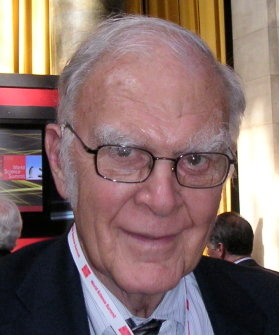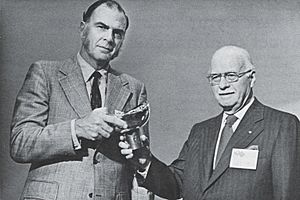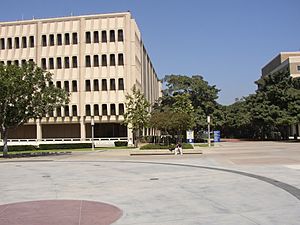F. Sherwood Rowland facts for kids
Quick facts for kids
Frank Sherwood Rowland
|
|
|---|---|

Rowland at the inaugural World Science Summit, May 2008
|
|
| Born | June 28, 1927 |
| Died | March 10, 2012 (aged 84) |
| Nationality | American |
| Alma mater |
|
| Known for | Ozone depletion research |
| Awards |
|
| Scientific career | |
| Fields | Chemistry |
| Institutions | University of California, Irvine |
| Thesis | The epithermal reactions of recoil atoms (1952) |
| Doctoral advisor | Willard Libby |
Frank Sherwood "Sherry" Rowland (born June 28, 1927 – died March 10, 2012) was an American chemist. He was a professor at the University of California, Irvine. He won a Nobel Prize for his work. His main research was about the chemistry of our atmosphere. He also studied how chemicals react. He is most famous for discovering that certain chemicals, called chlorofluorocarbons (CFCs), harm the Earth's ozone layer.
Contents
Early Life and Education
Frank Rowland was born in Delaware, Ohio. He went to public schools and finished high school early. He was almost 16 years old. During his high school summers, he managed a local weather station. This was his first experience with collecting data and doing experiments.
After high school, he went to Ohio Wesleyan University. Before he turned 18, he joined the Navy. He trained people to use radar. After 14 months, he left the Navy. He then went to the University of Chicago. There, he studied radiochemistry with his mentor, Willard F. Libby. Rowland earned his bachelor's degree in 1948. He received his master's degree in 1951 and his PhD in 1952. Both were from the University of Chicago.
Career and Ozone Research
Rowland worked at Princeton University from 1952 to 1956. Then he taught at the University of Kansas until 1964. In 1964, he became a chemistry professor at the University of California, Irvine. In the early 1970s, he started working with Mario J. Molina.
Rowland's most important discovery was about how chlorofluorocarbons (CFCs) affect the ozone layer. He believed that man-made gases like CFCs would break down in the upper atmosphere. Sunlight would cause them to release chlorine atoms. These chlorine atoms would then react with ozone, destroying it. He realized that one chlorine atom could destroy many ozone molecules.
His research was first published in Nature magazine in 1974. This led to a big scientific investigation. In 1978, the United States banned CFCs in spray cans. However, CFC production didn't stop completely. It took until the 1980s for countries around the world to agree on rules.
Rowland also took many measurements of the atmosphere. He collected air samples from different cities worldwide. This helped him see how CFCs were mixing in the atmosphere. Later measurements showed that CFC levels were steadily increasing. His work also showed how the ozone layer changed with the seasons. But over the years, the overall ozone levels were dropping.
Rowland and his team talked to the public and to politicians. They suggested ways to reduce CFC pollution. Countries like Canada, the United States, Sweden, and Norway first regulated CFCs. Later, global agreements like the Vienna Agreement and the Montreal Protocol helped control CFC emissions worldwide.
Awards and Recognition

Frank Rowland received many awards for his important work:
- Tolman Medal in 1976
- Elected to the American Academy of Arts and Sciences
- Leo Szilard Lectureship Award in 1979
- Tyler Prize for Environmental Achievement in 1983
- Japan Prize in 1989
- Peter Debye Award in 1993
- Albert Einstein World Award of Science in 1994
- Roger Revelle Medal in 1994
- The Nobel Prize in Chemistry in 1995
- Elected to the American Philosophical Society in 1995
- Golden Plate Award of the American Academy of Achievement in 1996
In 1998, the physical sciences building at the University of California, Irvine was named Rowland Hall in his honor. A statue of him is in the lobby. In 2007, a mountain in Antarctica was named Mount Rowland after him.
Personal Life
Frank Rowland had two children, Ingrid and Jeff. He also had two granddaughters. After a short illness, Rowland passed away on March 10, 2012. He had complications from Parkinson's disease. His friend and fellow chemist, Mario J. Molina, said that Rowland was a great influence on his career and inspired many others.
See also
 In Spanish: Frank Sherwood Rowland para niños
In Spanish: Frank Sherwood Rowland para niños


